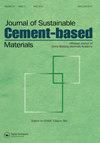部分饱和混凝土中氧扩散率的多尺度数值分析模型:界面过渡区的作用
IF 4.2
3区 工程技术
Q1 CONSTRUCTION & BUILDING TECHNOLOGY
Journal of Sustainable Cement-Based Materials
Pub Date : 2022-11-08
DOI:10.1080/21650373.2022.2143452
引用次数: 0
摘要
摘要本研究提出了一个多尺度模型来模拟部分饱和混凝土中的氧扩散率,考虑到混凝土的多尺度性质及其孔隙结构中的水气分布。在微观尺度上,3 模拟了水泥浆体ITZ的D微观结构,在此基础上,利用格子Boltzmann模型模拟了不同水饱和度(DWSs)下毛细管孔隙结构中的水-气平衡分布和氧扩散率。之后,a(n + 1) 采用基于有效介质理论的-相模型在中尺度上预测了非饱和混凝土中的氧扩散率。结果表明,随着DWS的增加,氧扩散率的演变经历了一个初始下降、一个平稳期、一个轻微下降和一个急剧下降,这对应于充气凝胶孔的减少、充气凝胶孔隙的解吸和充气毛细管孔的减少,直到它们的解吸。随着DWS的增加,ITZ在非饱和混凝土中的氧扩散作用变得更加显著。本文章由计算机程序翻译,如有差异,请以英文原文为准。
Multiscale numerical-analytical modelling of oxygen diffusivity in partially saturated concrete: Role of interfacial transition zone
Abstract This study presents a multiscale model to simulate oxygen diffusivity in partially saturated concrete accounting for multiscale nature of concrete and water-gas distribution in its pore structure. At microscale, 3 D microstructure of cement paste ITZ is simulated, based on which the water-gas equilibrium distribution in capillary pore structure and oxygen diffusivity at different degrees of water saturation (DWSs) are mimicked using lattice Boltzmann models. Afterwards, a (n + 1)-phase model based on effective media theory is used to predict oxygen diffusivity in non-saturated concrete at mesoscale. Results indicate that the evolution of oxygen diffusivity with the increasing DWS follows an initial drop, a plateau, a slight decrease and a sharp decrease, which correspond to the decreasing gas-filled gel pores, depercolation of gas-filled gel pores, and decreasing gas-filled capillary pores until their depercolation. The role of ITZ in oxygen diffusion in non-saturated concrete becomes more remarkable with the increasing DWS.
求助全文
通过发布文献求助,成功后即可免费获取论文全文。
去求助
来源期刊
CiteScore
6.60
自引率
15.90%
发文量
71
期刊介绍:
The Journal of Sustainable Cement-Based Materials aims to publish theoretical and applied researches on materials, products and structures that incorporate cement. The journal is a forum for discussion of research on manufacture, hydration and performance of cement-based materials; novel experimental techniques; the latest analytical and modelling methods; the examination and the diagnosis of real cement and concrete structures; and the potential for improved cement-based materials. The journal welcomes original research papers, major reviews, rapid communications and selected conference papers. The Journal of Sustainable Cement-Based Materials covers a wide range of topics within its subject category, including but are not limited to: • raw materials and manufacture of cement • mixing, rheology and hydration • admixtures • structural characteristics and performance of cement-based materials • characterisation techniques and modeling • use of fibre in cement based-materials • degradation and repair of cement-based materials • novel testing techniques and applications • waste management

 求助内容:
求助内容: 应助结果提醒方式:
应助结果提醒方式:


